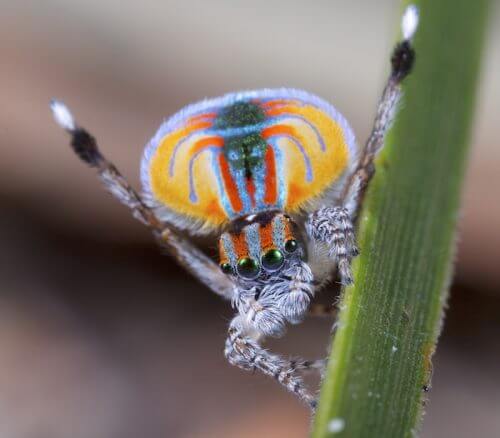The colorful belly of a 'Peacock Jumper' spider has been discovered as a possible source of inspiration for the development of new technologies in the field of optics

By: Amir Gildor
The abdomen of a 'Peacock Jumper' spider reflects light in all the colors of the rainbow, visible in iridescent patterns designed to attract females. The structure of the light reflection component on the spider's abdomen can be a source of inspiration for developments in the field of optics.
The tiny spider (about 2.5 millimeters long) of the species 'peacock jumper' (Maratus robinsoni), which originates in Australia, is recognized as having a unique coloration. This is thanks to the scales on his belly, which reflect light in all visible wavelengths and create a colorful pattern, apparently designed to attract females during the courtship process. This feature of the 'peacock jumper', that is, the repetition of all wavelengths, is not known in any other living creature. In order to understand how the unique coloration is created, an international research team was formed, consisting of biologists, physicists and engineers, which examined the spatial structure and the optical function of the spider's scales.
The optical and structural examination of the scales revealed that they form a sophisticated three-dimensional structure, which allows light to be refracted at small angles and separated into all the colors of the rainbow. The scales are similar in shape to a wing, and they include nanometer components that reflect light alongside components that do not reflect light, which contribute to the clear separation between the different shades.
Inspired by the discovered structure, the researchers built several different models and tested their optical properties. It was found that the structure that most accurately imitated the natural structure of the spider's scales had optical properties similar to it. This is in contrast to the other structures, which were built in light of the accepted optical methods, but did not succeed at all in reproducing the spider's natural reflection qualities.
The natural structure of the scales of the 'peacock jumper' is a possible source of inspiration for the improvement of conventional optical technologies that do not allow light to be refracted in this way. In fact, the research findings may enable the development of new technologies in the field of optics and to minimize existing tools and components for tasks where extremely small packages are required, for example, for missions in space.

One response
"Peacock spider", is a general name for the entire genus Maratus. I think that in addition to the species in question, the phenomenon exists in the entire genus. And of course it doesn't have an official Hebrew name, because the Committee for Zoological Terms does not deal with species that do not exist in Israel, with the exception of species that were here in the past, migratory species and the like.